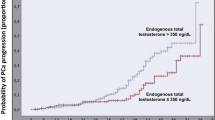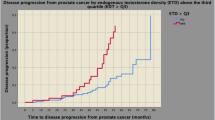Abstract
Purpose
To evaluate the clinical value of the pre-treatment calculated free testosterone (fT), total testosterone (tT), sexual hormone-binding globulin (SHBG) and estradiol (E2) levels as potential predictors of pathological stage and grade in patients with clinically localized prostate cancer.
Methods
Preoperative sex hormone serum levels were prospectively measured in 137 patients who underwent radical prostatectomy at the University Hospital Ulm from February 2011 to February 2012. We related sex hormone levels to clinicopathologic data including tumour stage, Gleason score and prostate specific antigen (PSA). (Non)parametric statistical tests and receiver operating characteristics (ROC) analyses were performed.
Results
Preoperative serum fT levels were significantly associated with advanced disease (pT3–4 and/or pN+; p = 0.047) and lymph node involvement (pN+) (p = 0.027). Patients with low (<0.047 μg/l) vs. normal fT values (≥0.047 μg/l) were associated with higher tumour stage (p = 0.049), positive lymph node status (pN+ , p = 0.038) and advance disease (p = 0.016). Moreover, low tT values (≤0.193 μg/l; p = 0.018) and elevated SHBG levels (>48.4 nmol/l, p = 0.043) correlated with a higher Gleason score. Conversely, E2 levels were not associated with tumour stage or grade. Applying multivariate analysis, unlike tT, SHBG, and E2 levels, low fT levels were a significant independent predictor of advanced disease (relative hazard ratio 3.05, p = 0.028).
Conclusions
Low pre-treatment fT levels were significantly associated with tumour stage and extraprostatic tumour spread and might—in addition or combination with PSA—serve as a useful prognostic parameter for prostate cancer patients prior to radical prostatectomy.

Similar content being viewed by others
References
Morgentaler A, Traish AM (2009) Shifting the paradigm of testosterone and prostate cancer: the saturation model and the limits of androgen-dependent growth. Eur Urol 55:310–320
Sher DJ, Mantzoros C, Jacobus S, Regan MM, Lee GS, Oh WK (2009) Absence of relationship between steroid hormone levels and prostate cancer tumor grade. Urology 73:356–361
Solania A, Gallina A, Briganti A, Abdollah F, Suardi N, Capitanio U, Colombo R, Freschi M, Rigatti P, Montorsi F (2011) Preoperative hypogonadism is not an independent predictor of high-risk disease in patients undergoing radical prostatectomy. Cancer 117:3953–3962
Ribeiro M, Ruff P, Falkson G (1997) Low serum testosterone and a younger age predict for poor outcome in metastatic prostate cancer. Am J Clin Oncol 20:605–608
Schatzl G, Madersbacher S, Thurridl T, Waldmüller J, Kramer G, Haitel A, Marberger M (2001) High-grade prostate cancer is associated with low serum testosterone levels. Prostate 47:52–58
Massengill JC, Sun L, Moul JW, Wu H, McLeod DG, Amling C, Lance R, Foley J, Sexton W, Kusuda L, Chung A, Soderdahl D, Donahue T (2003) Pretreatment total testosterone level predicts pathological stage in patients with localized prostate cancer treated with radical prostatectomy. J Urol 169:1670–1675
Lee SE, Chung JS, Han BK, Park CS, Moon KH, Byun SS, Choe G, Hong SK (2008) Preoperative serum sex hormone-binding globulin as a predictive marker for extraprostatic extension of tumor in patients with clinically localized prostate cancer. Eur Urol 54:1324–1332
Salonia A, Gallina A, Briganti A, Zanni G, Suardi N, Capitanio U, Colombo R, Bertini R, Freschi M, Guazzoni G, Rigatti P, Montorsi F (2011) Sex hormone-binding globulin is a significant predictor of extracapsular extension in men undergoing radical prostatectomy. BJU Int 107:1243–1249
Solania A, Briganti A, Gallina A et al (2009) Sex hormone-binding globulin: a novel marker for nodal metastases prediction in prostate cancer patients undergoing extended pelvic lymph node dissection. Urology 73:850–855
Hoffman MA, DeWolf WC, Morgentaler A (2000) Is low serum free testosterone a marker for high grade prostate cancer? J Urol 163:824–827
Morote J, Ramirez C, Gomez E, Planas J, Raventos CX, de Torres IM, Catalan R (2009) The relationship between total and free serum testosterone and the risk of prostate cancer and tumour aggressiveness. BJU Int 104:486–489
Bonkhoff H, Berges R (2009) The evolving role of oestrogens and their receptors in the development and progression of prostate cancer. Eur Urol 55:533–542
Carruba G (2007) Estrogen and prostate cancer: an elipsed truth in an androgen-dominated scenario. J Cell Biochem 102:899–911
Solania A, Gallina A, Briganti A, Suardi N, Capitano U, Abdollah F, Bertini R, Freschi M, Rigatti P, Montorsi F (2011) Circulating estradiol, but not testosterone, is a significant predictor of high-grade prostate cancer in patients undergoing radical prostatectomy. Cancer 117:5029–5038
Vermeulen A, Verdonck L, Kaufmann JM (1999) A critical evaluation of simple methods for the estimation of free testosterone in serum. J Clin Endocrinol Metab 84:3666–3672
Isom-Batz G, Bianco FJ Jr, Kattan MW, Mulhall JP, Lilja H, Eastham JA (2005) Testosterone as a predictor of pathological stage in clinically localized prostate cancer. J Urol 173:1935–1937
Imamoto T, Suzuki H, Fukasawa S, Shimbo M, Inahara M, Komiya A, Ueda T, Shiraishi T, Ichikawa T (2005) Pretreatment serum testosterone level as a predictive factor of pathological stage in localized prostate cancer patients treated with radical prostatectomy. Eur Urol 47:308–312
Teloken C, Da Ros CT, Weber FA, Cavalheiro AP, Graziottin TM (2005) Low serum testosterone levels are associated with positive surgical margins in radical retropubic prostatectomy: hypogonadism represents bad prognosis in prostate cancer. J Urol 174:2178–2180
Nishiyama T, Ikarashi T, Hashimoto Y, Suzuki K, Takahashi K (2006) Association between the dihydrotestosterone level in the prostate and prostate cancer aggressiveness using the Gleason score. J Urol 176:1387–1391
Zhang PL, Rosen S, Veeramachaneni R, Kao J, DeWolf WC, Bubley G (2002) Association between prostate cancer and serum testosterone levels. Prostate 53:179–182
Miller LR, Partin AW, Chan DW, Bruzek DJ, Dobs AS, Epstein JI, Walsh PC (1998) Influence of radical prostatectomy on serum hormone levels. J Urol 160:449
Conflict of interest
The authors declare that they have no conflict of interest.
Author information
Authors and Affiliations
Corresponding author
Additional information
Thomas Schnoeller and Florian Jentzmik equally contributed to this work.
Rights and permissions
About this article
Cite this article
Schnoeller, T., Jentzmik, F., Rinnab, L. et al. Circulating free testosterone is an independent predictor of advanced disease in patients with clinically localized prostate cancer. World J Urol 31, 253–259 (2013). https://doi.org/10.1007/s00345-012-0902-5
Received:
Accepted:
Published:
Issue Date:
DOI: https://doi.org/10.1007/s00345-012-0902-5




